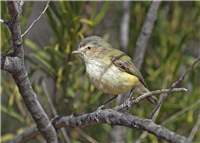Family
Pardalotidae
Genus
Smicrornis
Species
brevirostris
Threats/Control Methods - Regional
This woodland species is sensitive to land clearing and habitat simplification. Urban developments, agriculture, grazing and weed dispersal are all contributing to the declining health of their natural home.
Threats/Control Methods - Local
Within the suburbs, domestic Cats (Felis catus) are likely to attempt to hunt this species.
Local/Urban Actions
Gardeners can encourage the species by ensuring their yard consists of a good mix of trees, shrubs and ground litter. Cat owners can prevent their pets preying on the species by providing a stimulating indoor environment and by installing a cat run or enclosure.
Common Names
Weebill, Brown Weebill, Yellow Weebill, Yellow Tree-tit, Short-billed Shrub-tit, Short-billed Tree-tit, Southern Weebill
Distinguishing Features
The Weebill is a tiny, round, 9cm bird of pale greenish-brown plumage. It has a short, thick, pale bill and a creamy white eye.
Survey Techniques
Call and visual identification.
Species Call
Loud, clear 'weetiew-whit, whit' whistles.
Similar Species
Many other small brown birds look similar to the Weebill, although they often have coloured eyes. Thornbills (Ananthiza) in particular could be confused, however they have some spots or streaks on the head and face.
Distribution
The Weebill is found across mainland Australia.
Country of Origin
Australia.
Conservation (Pet/Pest) Status - Regional
Weebill numbers appear to be stable and are fairly constant over the year, with a slight rise in the winter breeding months (COG).
Conservation (Pet/Pest) Status - National
Secure, not listed under the EPBC Act 1999.
LSCCES Population
Weebills were found in moderate to low numbers across most of the survey sight, excluding CSIRO, NMA and Turner.
Associated vegetation community
Weebills prefer open dry eucalypt forest, woodland or mallee.
Limiting Resources
This species depends upon a complex habitat of mature trees, shrubs, fallen logs and ground cover.
Breeding
Weebills make a neatly woven nest from fine vegetation, varying in shape from domes to long ovals. Spiders white eggs sacs or caterpillar shells are often attached. The female incubates the 2-3 light pink-brown eggs for about 12 days and both parents care for the young for 10 days. In Canberra, nest building begins in mid July and most next activity is over by late November.
Behaviour
The birds are known to flutter around the outer foliage of trees for insects, spending most of their time in the tree canopy. They are seen in pairs or in small groups with Thornbills (Ananthiza) and Silvereyes (Zosterops lateralis ). They are locally nomadic, but stay roughly in the same area throughout the year.
Functional Group
Food Species
Weebills collect small insects of the outer leaves of treetops.
Predators
Feral and domestic Cats (Felis catus) may attack this species in the trees.
Interesting Fact
The Weebill is Australia's smallest bird.
References - (reader suitability of references, P=Primary teachers, S=Secondary students, T=Tertiary students and researchers)
Books:
Freudenberger, D. 2001. Bush for the birds: Biodiversity enhancement guidelines for the Saltshaker Project, Boorowa, NSW. Consultancy report to Greening Australia ACT and SE NSW Inc. CSIRO Sustainable Ecosystems. Canberra. S, T
Morcombe, M. 2000. Field Guide to Australian Birds. Steve Parish Publishing. Archerfield. Australia P, S, T
Veerman, P. 2003. Canberra Birds: A report on the first 21 years of the garden bird survey. Philip Veerman and Canberra Ornithologists Group. Canberra. S, T
Internet:
Birds in Backyards 2006. [online]. Available at:
http://www.birdsinbackyards.net P, S, T
Canberra Ornithological Group (COG). 2004. Birds of Canberra Gardens. COG and the ACT Department of Urban Services. [online]. Available at:
http://garden.canberrabirds.org.au/ P, S, T
Online Publications:
Nix, H. and Cunningham, R. 2006. Birds of the Lower Sullivans Creek Catchment, Canberra ACT. Prepared for the Life in the Suburbs project using data from the Lower Sullivans Creek Catchment Ecological Survey (LSCCES). Australian National University. Canberra. [online]. Available at: http://www.lifeinthesuburbs.com.au/category.php?id=65 S, T

 Top
Top Top
Top